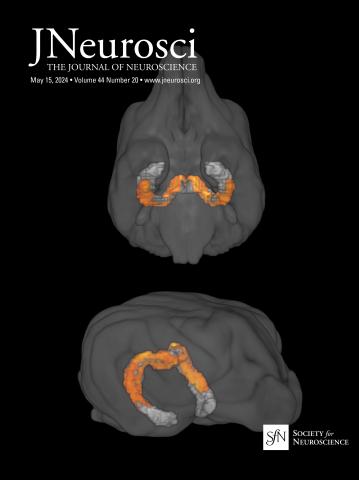Amygdala regulates social motivation for selective vocal imitation in zebra finches.
IF 4.4
2区 医学
Q1 NEUROSCIENCES
引用次数: 0
Abstract
Imitation plays a key role in the acquisition of speech and cultural behaviors. Studies suggest that social interaction facilitates imitative learning, indicating that neural circuits involved in social behaviors can also influence the process of imitation. Vocal imitation in juvenile songbirds serves as a valuable model to investigate this idea. Here, we explore the mechanisms of tutor-pupil social interaction and selective song learning in male zebra finches, with a particular focus on the amygdala, which can regulate social behaviors via its processing of values and emotions in mammals. When sequentially exposed to two tutors, normal pupils selectively learned song from the tutor who sang longer but less frequently. When hearing songs, pupils preferentially approached the selected tutor. Excitotoxic lesions of the amygdala increased pupils' social motivation toward tutors yet diminished their song-responsive approach, especially to the selected tutor. Whereas the pupils with amygdala lesions retained their ability to imitate song, the tutor selection became more unpredictable with diminished preference for a specific tutor. Neuronal tracing confirmed that the zebra finch amygdala is connected to the circuits involved in social functions but lacks direct connections to those critical for song control and learning. These results suggest that the amygdala regulates social motivation and tutor selection in juvenile zebra finches, highlighting its role in imitative learning.Significance Statement Social interaction plays a critical role in imitation, particularly in the acquisition of speech and cultural behaviors like dance and song. Although studies in rodents indicate the involvement of the amygdala in social behaviors and social learning, the mechanisms coordinating social behaviors and imitative learning remain poorly understood. Vocal imitation in juvenile songbirds is an ideal model to investigate such mechanisms. Here, we report that lesioning the amygdala in juvenile zebra finches increases overall social motivation but disrupts selective song learning and their preferential approach to the selected tutor. These findings provide new insights into the social function of the amygdala in imitation.斑胸草雀杏仁核调节选择性声音模仿的社会动机。
模仿在语言和文化行为的习得中起着关键作用。研究表明,社会互动促进了模仿学习,这表明参与社会行为的神经回路也可以影响模仿过程。鸣禽幼鸟的声音模仿为研究这一观点提供了一个有价值的模型。本文以雄性斑胸草雀为研究对象,探讨了斑胸草雀师生社会互动和选择性鸣叫学习的机制,重点研究了斑胸草雀的杏仁核,它通过处理哺乳动物的价值观和情绪来调节社会行为。当连续接触两个导师时,正常学生有选择地从唱歌时间更长但频率较低的导师那里学习歌曲。当听到歌曲时,学生们会优先接近选定的导师。杏仁核的兴奋性毒性病变增加了学生对导师的社交动机,但减少了他们对歌曲的反应,尤其是对选定的导师。尽管扁桃体受损的学生仍有模仿歌曲的能力,但随着对特定导师的偏好减少,导师的选择变得更加不可预测。神经元追踪证实,斑胸草雀的杏仁核与涉及社会功能的回路相连,但与控制鸣叫和学习的关键回路缺乏直接联系。这些结果表明,杏仁核调节着幼斑胸草雀的社会动机和导师选择,突出了其在模仿学习中的作用。社会互动在模仿中起着至关重要的作用,特别是在语言和文化行为(如舞蹈和歌曲)的习得中。虽然啮齿类动物的研究表明杏仁核参与社会行为和社会学习,但协调社会行为和模仿学习的机制仍然知之甚少。鸣禽幼鸟的声音模仿是研究这种机制的理想模型。在这里,我们报告了幼斑胸草雀杏仁核的损伤增加了整体的社会动机,但破坏了选择性鸣叫学习和它们对选定导师的优先选择。这些发现为研究杏仁核在模仿中的社会功能提供了新的见解。
本文章由计算机程序翻译,如有差异,请以英文原文为准。
求助全文
约1分钟内获得全文
求助全文
来源期刊

Journal of Neuroscience
医学-神经科学
CiteScore
9.30
自引率
3.80%
发文量
1164
审稿时长
12 months
期刊介绍:
JNeurosci (ISSN 0270-6474) is an official journal of the Society for Neuroscience. It is published weekly by the Society, fifty weeks a year, one volume a year. JNeurosci publishes papers on a broad range of topics of general interest to those working on the nervous system. Authors now have an Open Choice option for their published articles
 求助内容:
求助内容: 应助结果提醒方式:
应助结果提醒方式:


